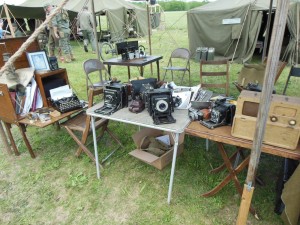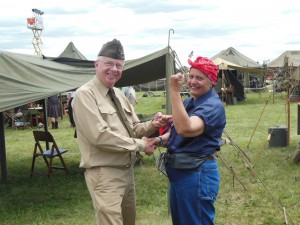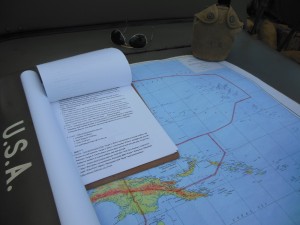MAAM WWII Weekend: Reenactors depict reality of wartime life at D-Day celebration
Three feisty World War II reenactors portray the indispensable women of Britain’s Auxiliary Territorial Service .
Reading, Pennsylvania reenactor Janet Brinker relaxes on a folding chair, patiently waiting for her ride. Her historic white nurses cap is marked with the familiar, reassuring Red Cross. Her modest blue-stripped dirndl is reminiscent of something grandmother might have worn. But when she turns to the side, her shoulder patch reveals an unexpected surprise. The patch represents her historic character’s hometown of Berlin, Germany.
Brinker is among the thousands of people – mostly reenactors – who are on hand this weekend for the Mid-Atlantic Air Museum’s (MAAM) WWII Weekend. The annual event, which is generally regarded as the largest and best of its kind in the United States, runs through Sunday in nearby Reading, Pennsylvania.

Like the multitude of living historians who have descended on the grounds of the Reading airport, Brinker is doing her part to preserve and present history.
For this weekend’s festivities, Brinker is portraying a German nurse.
“Nurses were not actually part of the German Army, and as such, they were not protected by the Geneva Convention. The fate of the nurses who served on the eastern front isn’t generally known, since there are no official records of who they were. But it is believed that there were between 1500-1600 nurses in the field as the Russians advanced. Only 5 survived the war. The last came home in 1954. It isn’t known how many were killed by the Russians or how many may have simply taken their own lives.”
One New Jersey resident, a beautiful young woman named Camille, was attending her first WWII event.
Camille looked incredibly stylish in a khaki uniform – complete with a garrison cap – while dancing in the Officer’s Club with Sinatra tribute artist, Frank Cubillo. Camille said she usually portrays characters from the 1960’s, mostly because, “I am a child of the 60’s.” But this weekend has also made her a fan of the 40’s.
“History was my worst subject in high school, and now as an adult it’s become my favorite. History is life. It may be past, but it existed and we’re all connected through it. I love it. After this experience, I will keep coming back to this event and bring more friends along.”
Meeting The Press
At the Army press tent, situated on the far side of the airfield, the 167th Signal Photo Company (Reenacted) presented an impressive display of the equipment corespondents and photographers took to war.
Navy veteran Bill Beam of Indiantown Gap, PA was one of the senior reenactors present to answer all questions. Beam said he served during the Korean War aboard the aircraft carrier USS Lake Champlain.
“Believe it or not I’m 81 years old. I’ve been doing this for 5 years now and will continue doing it for as long as I can.”
Beam said he and the other members of the group brought their collections out to show people what it was like for the journalists and photographers who covered the war – often moving right along side of the men fighting in the field.

“We do this because we want to educate people about what the press had to go through to get the pictures they took of the war.”
Joining Beam in the press tent was Chuck Berrier of Carlisle, PA. Berrier pointed out that General Eisenhower insisted the war be covered as closely and as accurately as possible. To that end, Ike had special passes made for the journalists and photographers which allowed the press almost unfettered access to the action.
“There were actually two different press corps factions,” Berrier explained. “One was regular army, which was the Signal Corps. They were regular soldiers. The other were private contractors who worked for the wire services: UPI, Time and Life magazines, etc. All of the wire services had their own people, as did the movie studios. The studios had the purse for photographers they could send over there.”
“All of these guys had a ‘go anywhere’ card. It was pink in color and had their picture on it. The card gave them the right to go anywhere they wanted and no officer could tell them they couldn’t do it. Of course everything you came up with was subject to military censor. It was a very, very interesting time for photographers and correspondents.”
On display were portable typewriters, vintage stationary, dozens of cameras and even a darkroom in a box. Berrier said most of the photographers used 4×5 Speed Graphic cameras, though some on the front lines preferred the more manageable 35mm models. Ironically, many of the better made cameras used by American photojournalists were crafted before the war in Germany.
“What we do here is show the cameras that were carried into battle; the issue and the non-issue cameras. We try as good as we can to represent what the people did who brought the war back to the folks at home and made it real for them.”
History You Won’t Find In A Textbook
Conversation about cameras was interrupted by a photo-op with Rosie the Riveter (Linda Johnson of Long Island) who teamed for pictures with Stanton Pratt as Maj. Gen Lyman Lemintzer.

Pratt, who grew up in Lemnitzer’s hometown of Honesdale, PA., is one of the lucky reenactors to portray a figure he personally knew. Though not necessarily a household name, Lemnitzer had a distinguished military career, serving as both the Chairman of the Joint Chiefs of Staff and the Supreme Allied Commander of NATO. During the war, Lemnitzer was assigned (respectively) to the staffs of both General Eisenhower and Lt. Gen. Mark Clark. In those posts, he helped form the plans for the North Africa and Sicily campaigns. But his notable career notwithstanding, it was while aiding Clark, Pratt recalls, that Lemnitzer entered the annals of Army legend.
“Somehow, Gen. Clark had lost his pants while fleeing from French Police while on a clandestine mission in Algeria. Clark said to Lemnitzer, ‘Lyman, I’m the senior officer here, and I’m not going back to that ship in front of the men in my skivvies. Give me your pants.’ So Lemnitzer relented, with the ludicrous result that he went aboard in his skivvies, while the much taller Clark wore borrowed trousers that almost appeared to be a pair of shorts.”
A View From The Men In The Air
In an area just west of the press tent, reenactors representing the U.S. Army Air Corps recalled life for the men who brought the war to the Enemy’s own backyard.
Phil Escobar, an Aberdeen, MD native who now lives in Frederick, MD, became interested in WWII reenacting after attending the now defunct Great Frederick Airshow. Now in his third year as a reenactor, Escobar discussed the war maps the group uses for their “mission” briefings.

“Some years ago, a treasure trove of authentic old war maps were found at Frostburg State University. Hundreds of them in pristine shape had been donated by someone. We were able to make jpegs of these maps and then blow them up to the original size on a wide format plotter. This way, we can recreate the era without having to worry about tearing an irreplaceable item.”
Escobar said his group – the Allied Airmen’s Preservation Society – Mid Atlantic District – teams with the crew of the B-25 J Mitchell bomber “Panchito” to stage the rescue of wounded airmen returning from a mission, then being moved to an army field hospital.
Joining Escobar for the morning briefing was Bruceton Mills, WV resident Patrick J. Ryan. A real-life pilot, Ryan has developed an affinity for the airmen of WWII and for some of the people who have made a lasting mark on the American landscape.
“Several years ago, I looked up Frank Buckles – a fellow West Virginian and the last surviving U.S. soldier from WWI. I just called him one day and said, ‘I’m not from the VA or anything. I just wanted to say thank you for what you did.’ My girlfriend at the time said, ‘You can’t just call someone like that out of the blue’, but I believe you need to let people like Frank Buckles know that you appreciate their sacrifice and that they have not been forgotten. We ended up spending a good bit of time talking on the phone about farming and horses. He invited me to give him a call if I was ever in Charles Town. I was there a few times on business but didn’t make that call. I’m kind of sorry now that I didn’t.”
Ryan’s experience with reaching out to luminaries from another era isn’t limited to those who served in the military. Ryan has also been in touch with several starlets from Hollywood’s halcyon days; women whose likenesses would have adorned innumerable footlockers and barracks walls.

Amongst his prized collection is an autographed still and Christmas card from Warner Bros. actress Joan Leslie.
“I wrote her a note to tell her about our group and included a picture of the guys. She replied with an autographed picture of her own in a card.” Reaching into his footlocker, Ryan said, “I’ve got the card right here.”
Gently removing the card from its envelope, Ryan insisted, “Let people know you appreciate them. Don’t just think about doing it “someday”. You never know. You might not be here.”
Ryan paused for a moment to reflect on the ones who are no longer here; the people who didn’t survive the war. Then he shared a few thoughts about D-Day and the present state of affairs.
“It’s sad to consider the price those guys paid storming the beach at Normandy; to think of so many of them over there who didn’t make it back. They gave up everything. All we have is our sense of loss. But you know what is really sad? If politicians continue to undermine this country and sell it out from under us, everything those guys did over there will have been in vain.”
“Maybe that’s what we should be talking about on D-Day.”
* * * * *
The 24th Annual World War II Weekend runs from June 6-8 at the Mid-Atlantic Air Museum, 11 Museum Drive, Reading, Pa. 19605. More information about the museum may be found here or by calling the museum office at 610-372-7333. Information about reserving warbird plane rides may be found here.
(Please read our first-hand flying experience when the Baltimore Post-Examiner flew in the B-17 Memphis Belle as well our cruise aboard the liberty ship John W. Brown.)
Credit all photos ~ Anthony C. Hayes
The 23rd Annual World War II Weekend runs from June 7-9 at the Mid-Atlantic Air Museum, 11 Museum Drive, Reading, Pa. 19605. More information about the museum may be found here or by calling the museum office at 610-372-7333. Information about reserving warbird plane rides may be found here.
(Please read our first-hand flying experience when the Baltimore Post-Examiner flew in the B-17 Memphis Belle.)
– See more at: https://baltimorepostexaminer.com/mid-atlantic-air-museum-showcases-largest-wwii-event-in-the-world-this-weekend-in-reading-pa/2013/06#sthash.IsZhAu8V.dpuf

Anthony C. Hayes is an actor, author, raconteur, rapscallion and bon vivant. A one-time newsboy for the Evening Sun and professional presence at the Washington Herald, Tony’s poetry, photography, humor, and prose have also been featured in Smile, Hon, You’re in Baltimore!, Destination Maryland, Magic Octopus Magazine, Los Angeles Post-Examiner, Voice of Baltimore, SmartCEO, Alvarez Fiction, and Tales of Blood and Roses. If you notice that his work has been purloined, please let him know. As the Good Book says, “Thou shalt not steal.”

I’ve been a WWII reenactor for 14 years and I take my impression seriously. Looks like Linda Johnson doesn’t take her impression seriously or else she would not be wearing a fanny pack!!!